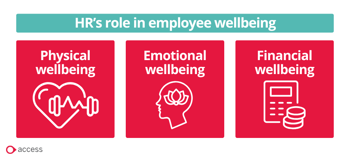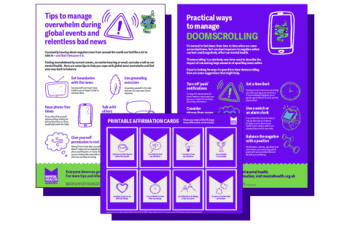
Why mental health matters in large organisations
In large organisations, the scale and complexity of operations continue to significantly amplify HR and mental health challenges. Dispersed teams, siloed departments, and high-pressure deadlines still create environments where mental health issues are often unnoticed or inadequately supported. These structural issues can make it difficult for HR to implement consistent wellbeing strategies throughout the employee lifecycle.
According to the 2025 CIPD & Simplyhealth “Health and Wellbeing at Work” survey:
- Sickness absence has risen sharply. UK employees took an average of 9.4 sick days in 2024, up from 7.8 in 2023 and 5.8 pre-pandemic.
- Mental ill health (for example depression or anxiety) is now the leading cause of long-term absence, reported by 41% of employers.
- For short-term absence, mental ill health is the second most common cause (29%), after minor illnesses such as colds/flu (78%). Stress / caring responsibilities also feature significantly (26%).
- Heavy workloads remain the top cause of stress-related absence, alongside management style.
- Around 64% of organisations are taking steps to identify and reduce stress, but only 50% believe their efforts are effective.
And what are the implications for large organisations?
These findings suggests that reactive support isn’t enough and preventative measures are needed. It also suggests that heavy workloads and management styles are still the major causative factors. Only half of the organisations feeling that their measures are effective can also be indicative of inconsistent implementation across large organisations, or insufficient tools and resources.
Workplace healthcare must be more equitable, reaching all employees with accessible, preventative support that includes those with pre-existing conditions. Traditional benefits often create cost and access barriers, especially for lower-paid workers with multiple health issues.
What is HR’s role in supporting mental health?
HR teams play a central role in shaping how mental health is supported across an organisation. This includes both strategic planning and day-to-day implementation. On a strategic level, HR can help integrate mental health into broader wellbeing and people strategies. Operationally, HR is often responsible for ensuring that support systems, policies, and resources are accessible and effective.
A strong approach to mental health typically involves alignment between policy, culture, and leadership. When these elements work together, it becomes easier to foster an environment where employees feel safe to speak up, seek help, and thrive.
How can HR help with mental health?
There are several practical ways HR can contribute to better mental health outcomes across the workforce, with examples including:
- Mental Health First Aiders: Trained colleagues who offer initial support and guidance.
- Employee Assistance Programmes (EAPs): Confidential services providing counselling and wellbeing resources.
- Flexible Working Policies: Options that support work-life balance and reduce stress.
These initiatives show how HR can help with mental health by making support more visible, accessible, and tailored to employee needs.
What is HR’s role in employee wellbeing?
Mental health is one part of a broader wellbeing picture. HR often leads efforts to support employees across multiple dimensions, including:
- Physical wellbeing: Health benefits, fitness programmes, and ergonomic workspaces.
- Emotional wellbeing: Resilience workshops, peer support networks, and mindfulness sessions.
- Financial wellbeing: Salary sacrifice schemes, financial education, and access to hardship support.
The HR role in employee wellbeing involves creating a balanced and inclusive approach that reflects the diverse needs of the workforce.
What is HR’s role in mental health strategy?
Long-term planning is key to building a sustainable mental health strategy. HR can contribute by:
- Providing training: Helping managers and teams develop the skills to support mental health.
- Engaging leadership: Encouraging senior leaders to actively support wellbeing initiatives.
- Tracking data: Using feedback, absence rates, and engagement metrics to evaluate impact and guide improvements.
The HR role in mental health strategy is about creating a framework that evolves with the organisation and supports employees over time.

What are some World Mental Health Day activities for your workplace?
Marking World Mental Health Day in the workplace offers a valuable opportunity to raise awareness, reduce stigma, and foster a culture of openness around mental health. Meaningful activities can help employees feel seen and supported, while also reinforcing the organisation’s commitment to wellbeing.
Whether your team is office-based, remote, or hybrid, there are many ways to tailor World Mental Health Day activities for the workplace to suit different working environments and team sizes.
Awareness campaigns and internal comms
Simple, visible actions can spark important conversations. Examples include:
- Posters and banners: Use downloadable materials from the Mental Health Foundation to decorate shared spaces or digital channels.
- Newsletters and intranet posts: Share tips on managing stress, links to support services, and personal stories from employees or leaders.
- Inclusive messaging: Focus on themes like “It’s okay to not be okay” or “Mental health affects everyone,” ensuring language is supportive and non-judgmental.
These tools help build visibility and encourage participation across the organisation.
The Mental Health Foundation provides posters and downloadable tip sheets that can provide advice on how to manage when it all feels too much. These include:
- Doomscrolling tips
- Overwhelm tips
- Affirmation cards
Workshops and speaker events
Interactive sessions can deepen understanding and create space for reflection. Consider:
- Inviting mental health professionals to lead sessions on stress, resilience, or coping strategies.
- Lived experience speakers who can share personal journeys and insights.
- Panel discussions or Q&A sessions to explore mental health in the workplace.
These activities for World Mental Health Day can be hosted in person or virtually, making them accessible to remote teams.
Team-based activities
Group activities can strengthen connections and promote wellbeing. Ideas include:
- Mindfulness or meditation sessions to encourage relaxation and focus.
- Walking meetings to combine movement with conversation.
- Gratitude walls (physical or digital) where employees can share what they’re thankful for.
- Tea & Talk mornings, a popular initiative from the Mental Health Foundation, where teams gather informally to chat and connect over tea or coffee.
For remote teams, consider virtual gratitude boards, online mindfulness sessions, or sending out digital conversation cards to spark discussion.

Sector-specific considerations for mental health
Mental health challenges can vary significantly across industries due to differences in working conditions, job demands, and cultural norms. Understanding these nuances helps HR and leadership teams tailor support strategies that resonate with employees experiences.
Mental health in manufacturing
In manufacturing environments, mental health can be impacted by factors such as:
- Shift work disrupting sleep and routine.
- Physical strain from manual labour or repetitive tasks.
- Stigma around discussing mental health, especially in traditionally male-dominated settings.
Addressing mental health in manufacturing may involve offering flexible scheduling, promoting open conversations, and ensuring access to support services that are visible and trusted by the workforce.
To explore how HR can address these challenges and improve support for manufacturing teams, read our blog on Manufacturing HR Employee Engagement which offers practical insights into workforce engagement, wellbeing strategies, and the importance of communication in industrial settings.
Mental health in retail
Retail workers often face:
- Customer-facing stress, including dealing with complaints or difficult interactions.
- Seasonal pressures, such as extended hours and increased workload during peak periods.
Supporting mental health in retail might include training on de-escalation techniques, access to EAPs, and wellbeing check-ins during high-demand seasons.
For actionable ideas on how HR can support retail workers through these challenges, read our blog on the 5 HR Challenges in the Retail Industry. The article highlights key stressors and offers guidance on improving wellbeing, retention, and morale in fast-paced retail environments.
Mental health in finance
The finance sector is known for:
- High-pressure environments with tight deadlines and performance targets.
- Long working hours that can lead to chronic stress and fatigue.
- Burnout, which is increasingly recognised as a serious concern.
Supporting mental health in finance may involve promoting work-life balance, offering resilience training, and encouraging leaders to model healthy behaviours.
To better understand how burnout manifests in finance and what HR can do to mitigate it, check out our blog on Addressing Burnout in Finance. This blog explores the causes of burnout and offers strategies for building resilience, improving work-life balance, and supporting mental health in high-stakes roles.
Expert Insight
Emma Parkin, Head of Propositions at The Access Group, discusses the workforce challenges that sectors like manufacturing and retail face. These workforce challenges can have a significant impact on mental health and wellbeing. Tackling these challenges is an important step in rooting out the multitude of causes of stress and anxiety in the workplace. For the full discussion and demonstration of PeopleXD Evo capabilities in tackling these challenges, watch the webinar, Strategic Workforce Management: Right People, Right Place, Right Time.
Measuring impact and continuous improvement
Tracking the effectiveness of mental health initiatives is essential for ensuring they deliver real value to employees and evolve with changing needs. By measuring engagement and outcomes, HR teams can identify what’s working, where gaps exist, and how to improve over time.
Common approaches include:
- Surveys and pulse checks: Regular feedback from employees helps gauge awareness, satisfaction, and perceived impact.
- Feedback loops: Creating channels for open dialogue, such as suggestion boxes or anonymous forums, can surface insights that formal surveys might miss.
- HR metrics: Monitoring absence rates, EAP usage, turnover, and engagement scores can reveal trends linked to mental health and wellbeing.
For expert guidance on building a mental-health-friendly workplace and tracking progress, SHRM offers a comprehensive toolkit and insights. It explores how HR professionals can support mental health while maintaining boundaries, and why continuous improvement is key to long-term success.
How to build a culture of care beyond World Mental Health Day
While World Mental Health Day is a powerful moment for awareness, creating a lasting impact requires ongoing commitment. HR plays a strategic role in embedding mental health into the fabric of the organisation. This can occur through policy, leadership engagement, and everyday practices that support wellbeing.
Building a culture of care means:
- Championing mental health year-round, not just during awareness days.
- Integrating wellbeing into employee experience, from onboarding to exit.
- Listening and evolving, using feedback and data to refine support strategies.
Whether you're just starting or looking to enhance existing initiatives, there are resources available to help. You can:
- Explore our Health & Wellbeing benefits page to see what support can be provided.
- Visit our Employee Wellness Hub for ideas, tools, and inspiration to strengthen your wellbeing strategy.
- Reach out to your HR team to share feedback, ask questions, or get involved in future wellbeing initiatives.
Creating a culture of care is a journey and every conversation, resource, and action helps move it forward.

 AU & NZ
AU & NZ
 SG
SG
 MY
MY
 US
US
 IE
IE
